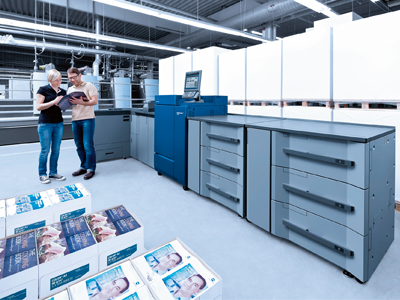The printing industry is undergoing fundamental changes, and print providers are now expected to do more with less. They therefore need to rethink their structures in order to be prepared for the constantly evolving digital economy.
Konica Minolta Production Print market development manager Mark Hinder outlines his four basic rules for business growth.
1) Get your house in order: raise process efficiency and optimise your workflows
Firstly, take a look at your back office processes and challenge their efficiency and quality. Automated workflows are the key to being competitive so that you can handle more jobs while at the same time reducing lead times. Software solutions for make-ready and professional print workflow automation are an essential tool for optimising print processing, minimising costs and maximising return on investment. Secondly, colour-controlled workflows will achieve an optimum quality print production as well as reducing downtime and cost. Customers consider colour consistency one of their main criteria for buying prints. Thirdly, inline finishing options simplify the production process, reduce set-up time, waste and resources. In this context, you can have a look at how many jobs can be produced in standardised formats to maximise productivity. According to an InfoTrends survey, 23% of print service providers agreed that finishing is a bottleneck in the overall print production workflow. Finishing processes are the least automated area in production workflows today.
2) Use modern methods and sales channels to communicate
After analysing back office processes, shift your attention to areas with direct customer touch points – let’s call it the front office check. One way could be the integration of your system into your clients’ systems. Use web to print systems so they can submit orders, proof them online and have real-time information and updates. You can adapt customers’ designs so that they feel more familiar and comfortable with the system.
Using web to print offers many advantages for you and your customer: it allows you to easily process large numbers of low-value orders in a business-to-business or business-to-consumer context. Furthermore, the client can use the opportunity to order a print 24 hours a day, so they are more flexible in their operating principles and save time. And last but not least, the client reduces printing costs thanks to the automated and fast workflow.
3) Offer new values for your customers
Create a new revenue stream by introducing variable data print and data management services as an added-value service. All products should be relevant for the recipient. As a result, the measures are more effective for the customer and they are satisfied with the cooperation.
For example, Konica Minolta helped UK Mail, one of the largest express delivery companies in the UK, develop its hybrid mailing service, imail, and has opened a new sort centre with print capability as part of a major investment. The new Livingston set up includes two Konica Minolta C8000 printers to print letters and marketing postcards and has led to four new jobs with plans for more investment and jobs next year.
Furthermore, applications such as photo books, on-demand book publishing, packaging, displays and transpromo print can be added to the product portfolio to surprise customers with new business opportunities that solve their pain points.
4) Use your experience to become a service oriented consultant
Spend more time with your customers than with technology, to find out what keeps them awake at night. Focus on the pain points in their business and help them overcome them. Learn to perceive yourself as a cross-media service oriented consultant. What about organising a series of events in your offices featuring the latest trends in your market for selected customers? Or think about having your own expert blog or Twitter channel with a customer service function. Furthermore, develop solutions and campaigns that get you away from a mere price conversation towards a quality conversation. This approach will transform your customer relationship into a long-term business partnership.
In times of disruptive technologies it is an important precondition for innovation and business success to leave the old behind. This is why production printers need to keep a close eye on their business. A business plan can structure your opportunities and business aims for a certain timeslot. If you are skeptical, a business development programme like Konica Minolta’s Digital 1234 can help you. It has been developed to take a hard look at the business and create an opportunity-based approach in order to grow.





